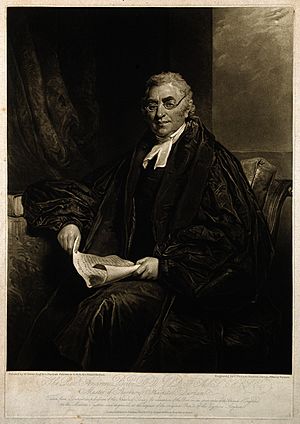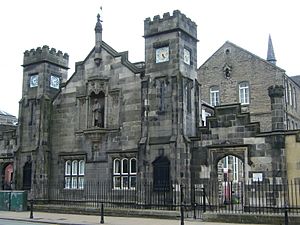Andrew Bell (educationalist) facts for kids

Andrew Bell (born March 27, 1753 – died January 27, 1832) was a Scottish Anglican priest and educator. He was famous for creating the Madras System of Education. This system was also called "mutual instruction" or the "monitorial system." He founded Madras College, a secondary school in St Andrews, and helped fund many other schools.
Contents
Andrew Bell's Life and Work

Andrew Bell was born in St Andrews, Scotland, on March 27, 1753. He went to St Andrews University and was very good at math and science. He graduated in 1774.
Early Adventures and Becoming a Priest
In 1774, he sailed to Virginia to work as a private tutor. He stayed there until 1781, leaving to avoid the War of Independence. He returned to Scotland after surviving a shipwreck. He then worked at an Episcopalian church in Leith. He became a deacon in 1784 and a priest in the Church of England in 1785.
Discovering the Madras System in India
In February 1787, Bell traveled to Madras, India, where he lived for 10 years. He became a chaplain for soldiers of the East India Company. In 1789, he became the leader of an orphanage for boys. These boys were the sons of officers who were either orphans or had no legal parents.
He saw some local children teaching each other the alphabet by drawing in sand. This gave him an idea. He decided to create a similar teaching method. He put brighter students in charge of teaching those who were not as bright. He also believed in using rewards instead of physical punishment.
How the Monitorial System Worked
In Bell's "Madras System," also known as the "monitorial system," one teacher would teach a small group of older or smarter students. These students were called "monitors." Each monitor would then teach the same lesson to a larger group of younger children. This way, one teacher could manage a very large class.
Spreading His Ideas in England
Bell left India in 1796 because of his health. He had saved a lot of money. He then wrote a book about his teaching system. From 1798, his system started to be used in some English schools. He spent his time spreading and improving his method.
He worked as a priest in Edinburgh for a short time. In 1801, he married Agnes Barclay. He later became the rector of St Mary's Church, Swanage in Dorset. There, he started a school for girls to learn straw-plaiting. He also used his system to teach young children. He and his wife helped many people in the area get the new smallpox vaccination. His marriage, however, did not last, and they separated in 1806.
A Rival and a Big Impact
Another educator, Joseph Lancaster, was also promoting a similar teaching system. Their ideas led to a long disagreement. One key difference was that Lancaster's schools were not connected to the Church of England, unlike Bell's.
Bell received strong support from the Church of England. His system was adopted in army schools and the Clergy Orphan School. In 1811, he became the leader of the new National Society for the Education of the Poor. This society set up schools using Bell's system. For his important work, he received special church positions. By the time he died, about 12,000 schools in Great Britain and its colonies were using his system.
Bell was very passionate about his system, but he could also be difficult to work with. However, he always got along well with children.
Later Life and Legacy

Bell retired to Cheltenham when he was 75 years old. He was a very wealthy man. He died at home on January 27, 1832, at the age of 78. He was buried in Westminster Abbey, a famous church in London.
His Final Wishes and Schools
He left almost all of his large fortune for education. He had some specific rules about how the money should be used. Besides Madras College in St Andrews, Bell also left money for schools in Inverness (now the Inverness Library), Glasgow, Edinburgh, Leith, and Cupar (now Bell Baxter High School). He also gave £10,000 to the Royal Naval School.
Why the System Didn't Last
Bell's teaching system did not last long after his death. It needed a lot of close attention and enthusiastic leaders. It worked best when there wasn't much money and very few teachers were available. As education changed, new methods became more popular.
See also
- Bell-Lancaster method
- Benjamin Jesty
- Learning by teaching (LdL)

